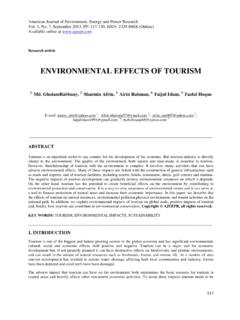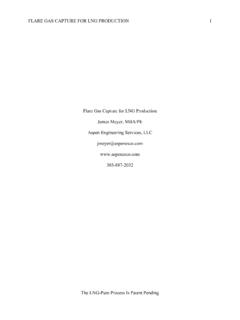Transcription of Risk Assessment and HAZOP Study of Oil and Gas Sector
1 American Journal of Environment, Energy and Power Research Vol. 1, No. 7, September 2013, PP: 151-158, ISSN: 2329-860X (Online) Available online at 151 Research article Risk Assessment and HAZOP Study of Oil and Gas Sector Meraj Ahsan Qureshi 1, Sarah Shakeel 2 1 Address: 50- B 2\1 Lawrence road Lahore 1 Phone: 042-36372797 2 Address:15-A Liaquat park sultan Ahmad road Ichhra Lahore 2 Phone: 042-37580967 1 2 _____ Abstract The Environmental Risk Assessment and HAZOP Study covers hazard management, record keeping and variety of Health, Safety and environment problems.
2 The main objectives of the Study are to evaluate existing risk management plan and HAZOP effectiveness in Oil and Gas Sector . The results shows, that the average noise level was found within the range of dB (A) during the Study against the National Environmental Quality standard 85dB (A), waste water parameters (pH, BOD, COD, TSS, TDS, Grease and oil, Chromium, Lead, Silver, Barium) were measured against the standards, some of the parameters like BOD (510 mg/L) and COD (1159 mg/L) were exceeding the range of standards.
3 Air emission parameters (CO, NOx and SO2) were measured but at some places like gas generator for power generation and heat medium skid NOx was (567 mg/Nm3) which was exceeding the National Environmental Quality Standards. In result, the data reveals that the workplace conditions are good and low permissible hazards were found because industry has proper management system and control over risks and hazards. Copyright AJEEPR, all rights reserved. Key Words: Environment Risk Assessment , HAZOP Analysis, Health & Safety, Oil & Gas Sector , Workplace, Hazards, Operability Study .
4 _____ Introduction In general environment includes air, water and land; all layers of the atmosphere; all organic and inorganic matter and living organisms; the ecosystem and ecological relationships; buildings, structures, roads, facilities and works all social and economic conditions affecting community life; and the inter-relationships between any of the American Journal of Environment, Energy and Power Research Vol. 1, No. 7, September 2013, PP: 151-158, ISSN: 2329-860X (Online) Available online at 152 factors which are described above (PEPA, 1997).
5 Risk is defined as the probability and severity that a certain event will occur. The event which has occurred or going to occur has some unwanted outcomes which can be positive or may be negative. The events which are going to be occur has some ranges which vary from minor to disastrous, which mainly depends upon the condition (Martha Grabowski, 2006). Therefore risk is defined as the result of frequency with which event is predicted to occur and the outcomes of that event. Risk = Frequency x Occurrence The frequency of that unwanted event is described as events per unit time, the frequency can be calculated by previous data, if it is easily available, or there are certain events happened in the past.
6 Usually risk analysis centers on events which has more severe results and low frequency for which the data is established (Martha Grabowski, 2006). The Hazard and Operability Study ( HAZOP ) form part of the Department s requirements for identifying and addressing hazards, and is a component of the integrated approval process The HAZOP process is used to identify potential hazards and operational problems in terms of plant design and human error. The technique should be applied to a plant during final design before construction commences, and there is some advantage in carrying out a preliminary HAZOP at an earlier stage to facilitate the design process (Avelino.)
7 , I. Mondlane., 2003) . This research identifies possible deviations from normal operating conditions which could lead to hazardous situations. The consequences and likelihood of such deviations are examined qualitatively. The adequacy and relevance of available safeguards to detect such deviations and prevent and/or protect against their resultant effects are also considered. This process enables a comprehensive evaluation of hazard control systems and produces recommendations for any necessary modifications.
8 The overall result is a reduction in both hazards and potential operational problems, and the possibility of reduced down-time and smoother commissioning (Mubin., 2008). Now a day s humans are living in the era of increasing frequency of environmental hazards, as population is continuously increasing , living standards are getting more improved and in same way the value of human property is decreasing, so by viewing this situation the environmental situation getting more worse and costly. Human s negligence can cause such hazards that cannot be fully rectified.
9 There should be an estimate about the loss of human as well as property so that authorities can allocate such resources to alleviate the effected people miseries, hence preparedness and awareness is provided so that impacts can be reduced (Korean. H. & Bisesi, M., 2004). The major concern of the industries of developing countries to focus on the occupational health and safety (OHS) and improving worker s productivity. Some common problems like improper work design, ill structured jobs, mismatch between worker abilities and job which worker demands, severe environment, poor human and machine system and inappropriate management.
10 These factors lead to workplace hazards, poor workers health, injuries and increase cost. Ergonomics or human factor can reduce or improve worker s productivity, OHS and satisfaction. All these have direct or indirect effect on overall performance. It would very difficult for any company to attain its objectives unless it has attained the proper consideration for ergonomics (Ashraf et al., 2004). MATERIAL & METHODS Study Area The group presently produces Oil & Gas from TAL Block as the operator of the concession.










